
DOWNLOAD
DATE
Contact
The demand for Private Campus Networks offers operators an opportunity for value generation – we estimate the global market size to be €60-70bn by 2025. If operators do not act now and prepare accordingly, they risk missing out. Enterprises have economically sensible use cases and technologically justified needs for private 5G or LTE technology on their premises. But, few operators to date have developed a strategic approach to satisfy demand, which is why enterprises have begun to fight for access to their own spectrum. Regulators are demonstrating a willingness to listen and to auction spectrum locally. New disruptive players are emerging with simple “out of the box” network solutions. These developments taken together are paving the way for enterprises to source private networks without operator involvement. We believe it is time for operators to fully embrace the opportunity and formulate a more industrialized approach to campus networking.
Enterprises have economically sensible use cases and a technologically justified need for private 5G or LTE technology on their premises
New digital use cases like predictive maintenance, AR/VR and smart robotics are increasingly used in day-to-day operations and bring tangible benefits on either or both the cost (productivity gains) or revenue (new customer propositions) sides, resulting in attractive business cases.
Physically, the place where significant digitalization happens is on campuses (defined as enterprise-controlled localized environments). For digital campus use cases to work, the required networking, computing and storage capacity must be in place. On top of that, companies need to be able to secure and manage their networks adequately to run applications.
Most commonly used access technologies do not meet enterprise connectivity requirements. While campuses often do have sufficient throughput in their existing LAN, the access technologies are either too costly (wireline) or too low range (Wi-Fi) or are not suitable for mobile use cases. For example, remotely operating a factory with smart robots across a large campus such as an airport will not be feasible within a Wi-Fi network, as there is no/poor handover functionality. On the other hand, public cellular networks cannot be used due to a lack of throughput, latency and/or security.
Therefore, until now, a combination of public and private networks with multiple technologies has often been deployed independently on campuses. This results in integration complexity, lack of flow control & security, and typically, insufficient coverage.
With Private Campus Networks, many of the current challenges can be solved. Homogeneous indoor and outdoor coverage, multi-technology integration and increased control and security are paving the way for digitalization from a networking perspective.
Few operators have so far developed a strategic approach to seize this opportunity, which may be relevant for as many as 15mn campuses globally. We believe operators need to prepare a suitable value proposition and we believe they need to do it now.
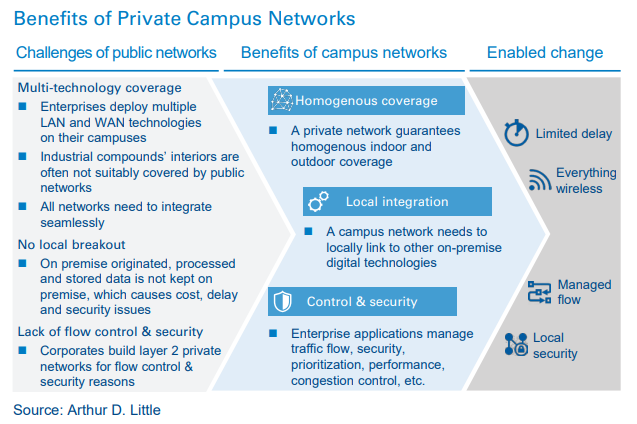
Operators need to act now, as enterprises have begun to find access to spectrum themselves and source technology from both established and new vendors in the market
Private networks are not new. Railways have had private rail networks for decades and 2G mobile spectrum slices were auctioned >10 years ago for local, private usage. However, this did not trigger a bigger wave of adoption since both the technology and use cases were not mature enough for value creation. Today, with both enhanced LTE and emerging 5G capabilities delivering network and use cases, the story is different. There are three drivers for operators to take immediate action: industry demand, regulatory change and new vendors.
- Industry demand: Demand has already been demonstrated by numerous Private LTE Campus Networks in operation across the globe, which help campuses such as mines, stadiums and manufacturing facilities securely digitalize operations. Furthermore, demand in Germany is already sufficiently large that industrial players are publicly criticizing operators’ lack of dedication to satisfy their networking demands, which are driven by compelling digitalization use cases.
- Regulatory change: Multiple players are lobbying for access to spectrum in the coming wave of MM wavelength auctions in Europe. Regulators clearly are listening given the willingness to auction regional/local spectrum, as seen in Austria, Sweden, France and Germany. In the US, the regulatory structure also provides various opportunities for Private Campus Networks to operate within the unlicensed CBRS 3.5 GHz band, controlled usage of which is enabled by software from companies like Federated Wireless.
- New vendors: Apart from enterprises pushing for Private Campus Networks themselves, new vendors (e.g., Ruckus) as well as smaller system integrators (e.g., Airspan, Challenge Networks) are already approaching enterprises directly with private network solutions. Ruckus is partnering with AWS and Athonet to offer an “out of the box corporate network” private LTE solution. Utilizing the unlicensed CBRS spectrum, the main value propositions are easy-todeploy, reliable and secure as well as lower cost compared to traditional LTE solutions. These can be managed and used even by non-telco IT personnel and run in the cloud for flexibility and ease of use.
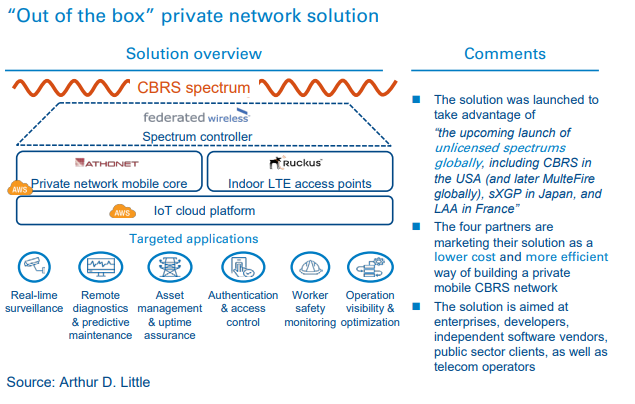
Other players that provide cost-effective solutions tailored to private networks include Parallel Wireless (RAN) and Accelleran (small cells). Operators should leverage vendors’ activities to develop attractive packages otherwise they risk being left out.
A large number of Private Campus Networks have already been built
Various mines, utilities, manufacturing sites, stadiums and ports have already built Private Campus Networks to enable their digitalization goals. Across different spectrum frequencies they provide the required connectivity and security for use cases such as smart manufacturing, mission-critical communications, enhanced video content, process optimization, etc.
Many of the installed private LTE networks on enterprise campuses are already independent from traditional MNO spectrum. With new spectrum becoming more widely available to non-MNOs, the competitive landscape for Private Campus Networks will increasingly open up.
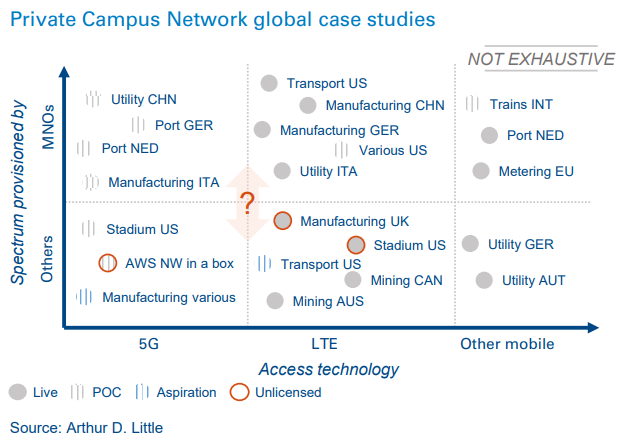
We believe it is time for operators to fully embrace this opportunity and formulate a more industrialized approach to campus networking
The demand for Private Campus Networks offers an opportunity for operators to drive revenue growth. However, new competition is not sleeping, thus operators need to do two main things:
- Defend their competitive advantage as a provider of licensed spectrum.
- Attack the opportunity:
- Products: Develop the right product/service portfolio
- Segments: Develop the right go-to-market strategy
In order for operators to not lose their role as connectivity provider, they should first defend their competitive (economies of scale) advantage as national providers of cellular networks, and lobby against regional spectrum. This depends on the national regulatory situation and the argumentation needs to be market-specific (i.e., number of MNOs, strength of industrial lobby, fixed network coverage, etc.). If successful, operators can always capture a part of the pie, at the very least as a connectivity (e.g., spectrum slice) provider.
Irrespective of the design and timing of future spectrum auctions, operators need to prepare strategically in order to attack the opportunity effectively. Creating the right product/ service portfolio is one requirement - we see a campus networking portfolio consisting of six categories:
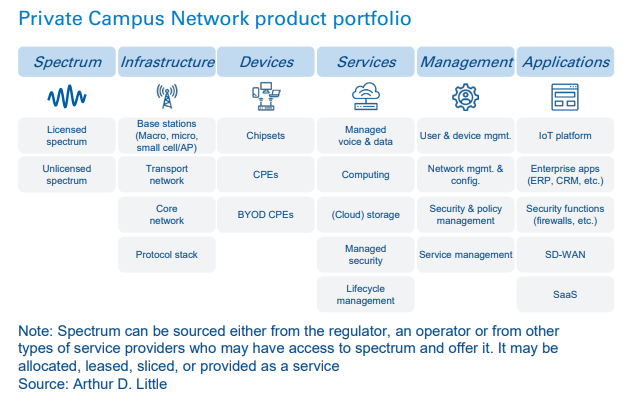
The ability to deliver these service “modules” is crucial and will require operators to surround themselves with the right partners. Not all equipment vendors are preparing in the same way and the playing field in the application space is broad.
Operators need to offer sufficient flexibility to campus customers in combining products into attractive packages tailored to campus requirements. A modular portfolio approach is an effective way to satisfy demand while limiting costs. The requirements will depend on the type of campus; we differentiate between four types, which differ in coverage (local/ distributed), purpose, connectivity quality requirements, and connected devices.
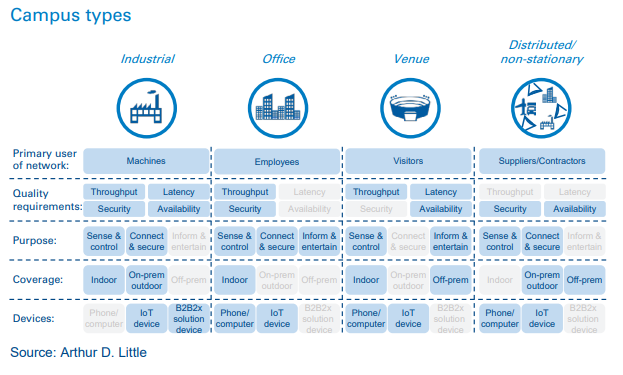
The motivation to attack the opportunity slightly differs between operators with an existing B2B footprint, and challengers. While the former face the threat of losing market share in their core business to new players, challengers have the opportunity to enter a new market relatively easily. The angle of attack also slightly differs between the two. Existing B2B players should focus on their core strength of managed connectivity and provide a more flexible and tailored proposition towards campus clients. For challengers, offering (parts of) their spectrum can be a ‘hook’ to enter the B2B world. By setting up an ecosystem of capable partners (e.g., vendors & solution providers) they can position themselves as an enabler of industry digitalization and win market share.
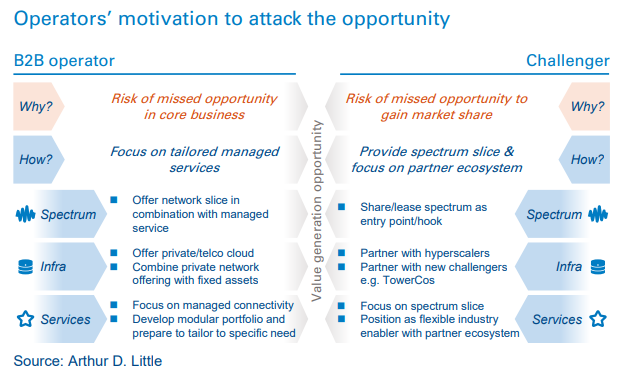
Ultimately, both categories of telcos need to act now to make the most of this opportunity.
Preparing the right strategic approach is crucial – there are four key steps: Overall strategy development (opportunity sizing, capability review), go-to-market strategy (portfolio development, delivery model, partnering), setup of a customer collaboration organization, and finally execution.
Conclusion
Demand for Private Campus Networks is on the rise. With many campuses already enabling digital use-cases via LTE (and with 5G emerging), the question is not “if” or “when”, but instead “where” and “how” operators can generate value and retain their position in the value chain. Operators are under pressure to reverse regulatory trends and fend off new competitors entering their territory. To make the most of the opportunity, operators must define a clear strategic approach to helping enterprise campus clients achieve their digitalization goals through implementing dedicated Private Campus Networks.



